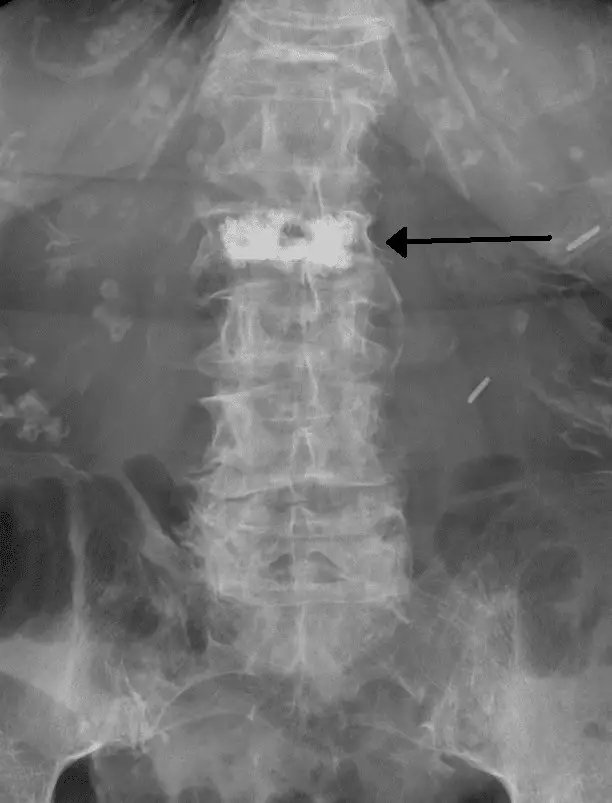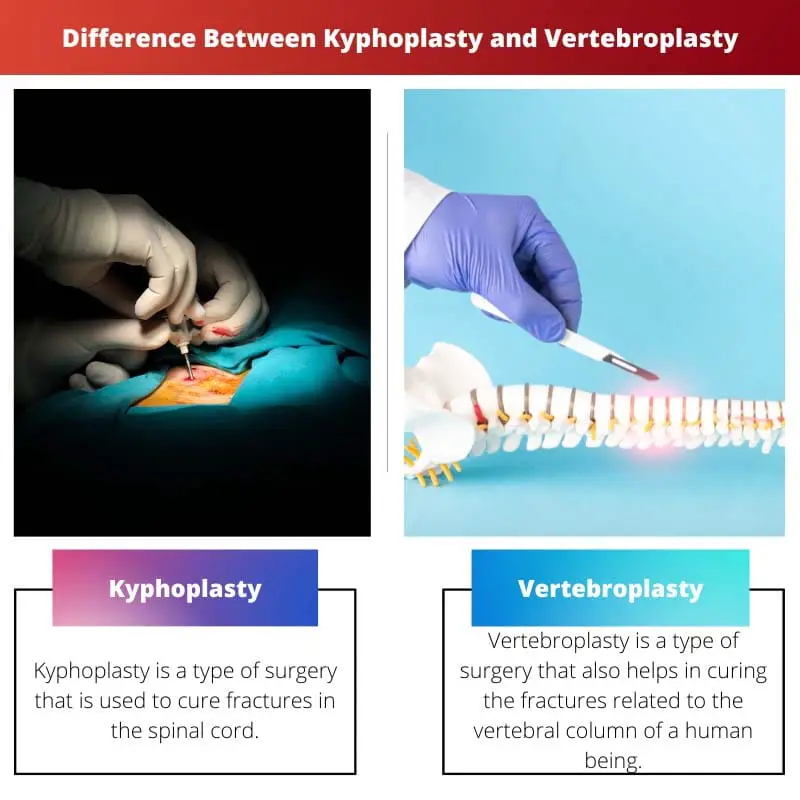The two most common forms of vertebral augmentation procedures are vertebroplasty & kyphoplasty. Such procedures are used to cure vertebral compression fractures, alleviate backache, and try to prevent further implosion.
Both vertebroplasty & kyphoplasty seem to be minimally invasive processes that involve implanting cement into a fractured vertebra to stabilize the spinal column.
Key Takeaways
- Kyphoplasty involves inflating a small balloon to create a cavity before injecting the bone cement, while vertebroplasty injects cement directly into the fractured vertebra.
- Kyphoplasty aims to restore vertebral height and correct spinal deformities, while vertebroplasty focuses on pain relief and stabilization.
- Kyphoplasty has a lower risk of cement leakage than vertebroplasty.
Kyphoplasty vs Vertebroplasty
Vertebroplasty is a minimally invasive procedure that involves the injection of bone cement directly into a fractured vertebra. A small incision is made in the skin. Kyphoplasty is a minimally invasive procedure that is similar to vertebroplasty but involves the use of a balloon to create a space for the bone cement.

Kyphoplasty is a type of surgery that is used to cure fractures in the spinal cord. These fractures are small cracks in a large mass of bone which is the most important part of an individual.
The spinal cord is configured to the whole stability of an individual. So, the healing of these fractures is a must.
Vertebroplasty is a type of surgery that also helps in curing the fractures related to the vertebral column of a human being. In this procedure, the area is numbed to reduce the sensations and then a balloon is inserted into the crack.
During this procedure, cement is used to seal the area and reduce the pain suffered by the individual.
Comparison Table
| Parameters of Comparison | Kyphoplasty | Vertebroplasty |
|---|---|---|
| Success Rate | 1 and 3 years,85.2% and 59.9%, respectively | 73 to 90 percent |
| Time taken | 1-2 hrs | 1 hr |
| Recovery | Pain relief will be immediate for some patients | pain relief within 24 to 48 hours |
| Disadvantage | Bone cement leakage, Paralysis, Pain persists or worsen. | Hemorrhaging, Blood loss, Fractures of ribs or other nearby bones, Fever. |
| Advantage | Significant and sustained reduction in back pain, Sustained vertebral body height restoration, Significant and sustained improvement in quality of life. | effective and safe procedure |
What is Kyphoplasty?
Many elements of kyphoplasty seem to be comparable to those of vertebroplasty. Both in processes, you are fully conscious but not in pain.
A main distinction between the two would be that Doctor first involves inserting a blimp into the rupture space in kyphoplasty. The doctor inflates the blimp to raise the crumbled vertebrae.
The balloon’s stress elevates the spine. This same existence of the balloon as well compels the gentle internal parts of the bone upwards, squishing it and forming a steady cavity inside the recently opened space.
The pocket is then filled with PMMA by the doctor. This same cement not just to fills & stabilizes the rupture, but also restores the quantity and height lost due to contraction.
Both processes take less than an hour for every vertebra treated. You may have to wait hours before actually returning home.
Healing begins within just a few days but can last up to 6 weeks.
Kyphoplasty is indeed the minimal intrusive interference that is effective for the treatment of VCF that has not responded to conservative therapy;
it provides immediate pain medication and improves hurt on VAS, life quality, and pulmonary function.
Even though it is a mildly invasive technique, it does have difficulties, which should be considered.
Secondary shatter to vertebrae along each, as well as secondary due to cement leakage inside the intervertebral disc, which is most frequent in kyphoplasty.
It is associated with a greater incidence of cardiac death than vertebroplasty. Spondylitis infected with extradural abscess just at operated vertebrae location.
An analysis revealed that surface-level wound infection, like any invasive surgery, occurred within 10 days of KP.
What is Vertebroplasty?
If you are experiencing pain or lack of mobility as a result of gentle stress fractures, you could be an applicant for vertebroplasty.
This same faster and easier of the 2 methods is vertebroplasty. Vertebroplasty, instead of trying to restore height to one broken spine, seals the fractures & stabilizes your bones.
The doctor will first take X-rays as well as other imaging tests to identify the location of your stress fractures, as he does with kyphoplasty.
After receiving sedation and anesthetics to relieve the pain, users lie prone just on the examination table while Doctor inserts a thin needle into the compression fractured vertebra.
The needle is guided straight to the rupture by the doctor using fluoroscopic guidelines. She after which gradually injects a particularly unique cement known as polymethylmethacrylate (PMMA) into the fracture to tight and stabilize it.
To fill the remaining space, this same doctor may have to administrate over one injection. Vertebroplasty stabilizes your vertebrae, allowing you to move freely even without pain.
However, since it does not restore height to a crumbled vertebra, it is only appropriate for straightforward or hairline fractures.
The most serious side effect of a vertebroplasty process is the inadvertent injection of PMMA outside of the vertebral bone. Immediate interaction with the nerve endings or spinal cord may result in nerve injury.
If indeed the cement is exerting pressure on the spinal column or nerves, surgical resection may be required. If too much cement reaches the spinal canal, say more than 5cc/mL, it can end up causing spinal injuries and paresis.
High-quality scanning, on the other hand, will detect any such leakage before they become big enough to cause severe problems.

Main Differences Between Kyphoplasty and Vertebroplasty
- In case of Kyphoplasty the confirmed hit rate is 85.2 percent, whereas the 3-year class has a 59.9 percent success rate, and vertebroplasty has a rate of success of 73-90 percent.
- The time required for attempting Kyphoplasty is 1-2 hrs whereas Vertebroplaasty takes 1 hour as for the procedure of surgery.
- The recovery of pain in kyphoplasty is instant after the surgery whereas Vertebroplasty takes 24 to 48 hours in pain relief after surgery.
- The advantages of Kyphoplasty are Significant and sustained reduction in back pain, vertebral body height restoration, and sustained improvement in quality of life whereas Vertebroplasty effective and safe procedure.
- The disadvantages of Kyphoplasty can be bone cement leakage, Paralysis, Pain persists or worsens whereas disadvantages of Vertebroplasty Hemorrhaging, Blood loss, Fractures of ribs or other nearby bones, Fever.

- https://journals.lww.com/spinejournal/Abstract/2006/11010/Balloon_Kyphoplasty_and_Vertebroplasty_for.19.aspx
- https://journals.lww.com/spinejournal/Abstract/2001/07150/New_Technologies_in_Spine__Kyphoplasty_and.2.aspx

Although the advantages and disadvantages of kyphoplasty and vertebroplasty are outlined, the potential complications associated with the procedures cannot be overlooked. The risks posed by these techniques should be carefully considered.
The comparison table provides a clear, concise overview of the differences between kyphoplasty and vertebroplasty, making it easier for readers to make informed decisions regarding these procedures.
The detailed explanations of kyphoplasty and vertebroplasty enable readers to comprehend the intricate nature of these procedures, leading to greater awareness of their benefits and potential drawbacks.
The detailed description of kyphoplasty and vertebroplasty offers a comprehensive understanding of the processes involved in these procedures, shedding light on their effectiveness and possible difficulties.
This article offers an insightful explanation of the two common forms of vertebral augmentation procedures, allowing readers to fully understand the differences and advantages of each
The article effectively highlights the importance of kyphoplasty and vertebroplasty in the management of vertebral compression fractures, providing valuable information for individuals considering these treatment options.